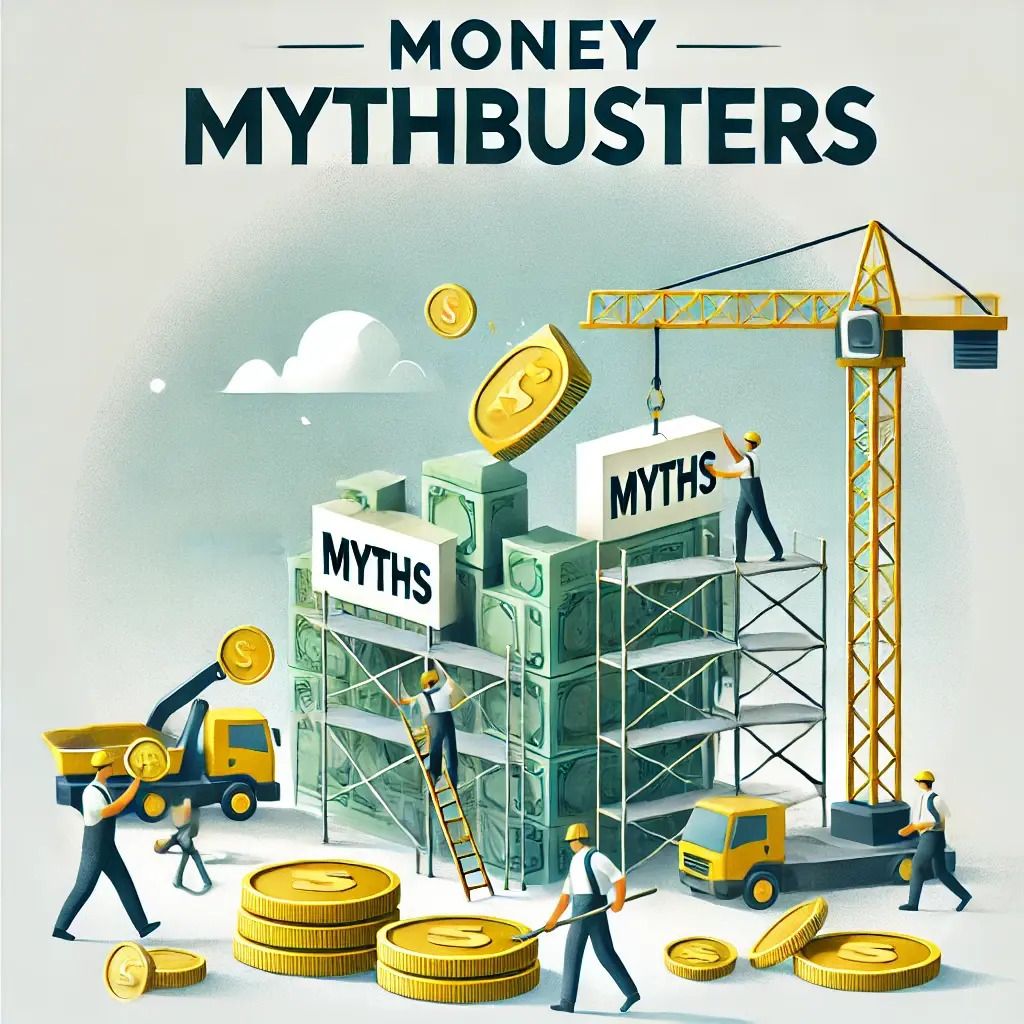- Your Money Mentor Minute
- Posts
- Your Money Mentor Minute
Your Money Mentor Minute
Your weekly dose of financial wisdom, strategies, and quick wins to help you learn to master your money!
Introduction
Welcome to this week’s edition of Your Money Mentor Minute! This week, I’m covering more simple strategies to grow your wealth, debunking a persistent money myth, and sharing various tools & tips to help you manage debt, begin to save and invest, and budget like a boss. This week, I touch on the theme of preparing your finances for a Move Abroad. Let’s get started!
Your Weekly Wealth Builder
This Week's Tip: Use the Rule of 72 to set realistic wealth-building goals.
Why It Matters: Knowing how long it takes for your money to double can help you strategize your savings and investments effectively. The Rule of 72 offers a simple way to calculate this, giving you clarity and confidence in your personal financial planning process.
How to Do It:
Understand the Rule of 72:
Divide 72 by the annual return rate of your investment. The result is the approximate number of years it takes for your money to double.Example: An 8% annual return means your investment doubles in 72 ÷ 8 = 9 years.
Choose Your Investment Wisely:
Higher returns typically mean shorter doubling times. Consider:Low-Cost Index Funds (e.g., VTI, IVV, or QQQM): Historical returns around 8-10%.
High-Yield Savings Accounts or Bonds: Lower returns, typically 2-4%, so doubling takes longer.
Set a Target Goal:
Use the Rule of 72 to plan. Want $100,000 to double to $200,000? At a 6% return, it’ll take 12 years (72 ÷ 6).Start Today:
Contribute regularly to your investment account, no matter how small.
Let compound growth do the heavy lifting over time
Solution: Don’t wait to start—time is your biggest asset, or it can be your biggest adversary as well. Use the Rule of 72 to visualize your long-term growth and make decisions that keep your financial goals on track.
Want help setting up an investment plan? Let me know—I’m here to guide you!.
Your Money Mythbusters
Myth: "Investing is too risky—you’ll just lose ALL your money."
Truth: Risk is part of investing, shoots it’s a part of everyday life, but with the right strategy, and understanding your tolerance for taking financial risk, you can minimize losses and grow your wealth over time.
Explanation:
Risk comes from not knowing where your money is going. By diversifying across asset classes like Large Cap, Mid Cap, Small Cap equities, bonds, and cash, you spread out risk and protect yourself from market fluctuations.
There are multiple investment options you can use like ETFs, Mutual Funds, and investing in actual stocks & bonds as well.
Long-term investing smooths out short-term volatility. Historically, the S&P 500 has averaged a 10% annual return, even with occasional dips.
Example:
Let’s say you invest $1,000 in a diversified ETF like the Vanguard Total Stock Market ETF (VTI). Even if the market drops by 10% one year, history shows it’s likely to recover in the following years.
By staying invested for 10+ years, you reduce the impact of short-term losses and benefit from compound growth. This is an example of why time is your greatest asset.
Solution: Start with Index Funds: ETFs like VOO or IVV are low-cost, diversified, and great for beginners.
Think Long-Term: Don’t try to time the market—invest consistently and give your money time to grow.
Set an Emergency Fund First: Keep 3-6 months of expenses in a savings account to avoid withdrawing investments during emergencies.
The real risk? Not investing at all. Start small, stay consistent, and let time and diversification work for you!.

Your Debt-Free Diaries
Real Story: How Alex (not his real name) Paid Off $15,000 in Student Loans in 18 Months.
Challenges: Alex struggled with variable interest rates that increased his loan payments unpredictably.
He felt overwhelmed by the sheer size of his debt and didn’t know where to start.
Strategies:
Avalanche Method: Alex focused on paying off the loans with the highest interest rates first. This saved him over $2,000 in interest payments compared to sticking with minimum payments alone.
Budget Overhaul: By using the 50/30/20 rule, Alex found extra room in his budget. Cutting dining out expenses saved him $250/month to put toward his loans.
Income Boost: Alex temporarily worked overtime shifts and used his year-end bonus to make an additional $3,000 lump-sum payment.
Results: Alex paid off $15,000 in 18 months, freeing up $450/month in loan payments. With his student loans gone, he now contributes $200/month to a Roth IRA and $250/month to a travel fund.
Solution:
Create a debt repayment plan using a calculator like Undebt.it.
Use the Avalanche Method: Focus on the debts costing you the most in interest.
Leverage Extra Income: Put bonuses, tax refunds, or side hustle earnings directly toward debt.
Track Progress: Use a debt-tracking app like Undebt.it to stay motivated.
Debt freedom starts with a plan—what’s your next step?
Your Retire Smart, Not Late
Retirement Insight: Diversify Your Retirement Savings with a Roth IRA.
Why It Matters: Roth IRAs offer tax-free growth and withdrawals in retirement, giving you flexibility and reducing your tax burden when you’re no longer earning an income. Diversifying between tax-deferred accounts like a 401(k) and tax-free accounts like a Roth IRA ensures you have options to manage taxes strategically in retirement.
How to Do It:
Open a Roth IRA:
Choose a trusted platform like Fidelity, Vanguard, or Schwab.Set Up Contributions:
For 2023, you can contribute up to $6,500 annually (or $7,500 if you’re 50+). Automate monthly contributions to stay consistent.Choose Investments Wisely:
Invest in low-cost index funds like the S&P 500 ETF (VOO) or a total market ETF (VTI) to keep fees low and growth potential high.
Example:
With a $60,000 salary and a 5% match, contributing $3,000 earns you an additional $3,000 from your employer. Over 30 years, assuming an 8% annual return, that extra $3,000/year could grow to over $450,000.
Solution: Even if you’re maxing out your 401(k), consider adding a Roth IRA to your retirement strategy. Starting with just $50 or $100 a month can build substantial tax-free wealth over time. Make sure you’re under the income limits ($153,000 for single filers in 2023) to qualify, and the max annual contribution into an IRA is $7,000 for people under 50, and $8,000 for those 50 and over..
Plan for a smarter, more flexible retirement by diversifying today!
Your Move Abroad Spotlight
Topic of The Week: 5 Financial Steps to Take Before You Go
Create a Relocation Budget:
Factor in visa fees, flights, housing deposits, and unexpected costs. Build a cushion to handle surprises.Open Multi-Currency Accounts:
Use tools like Wise or Revolut to avoid high exchange fees and simplify international transactions.Understand Tax Implications:
Research how your move will impact your tax obligations in both your home country and your destination. Don’t forget about double taxation treaties.Plan for Healthcare:
Explore health insurance options abroad to ensure you’re covered in case of emergencies.Keep a U.S. Address and Bank Account:
Having a U.S. mailing address can simplify ongoing financial matters, such as tax filings and maintaining retirement accounts.🌍 Your Move Abroad Checklist: Download a detailed relocation budget template HERE to kickstart your planning!
Your Budget Boss Blueprint
Budget Tip: Use the 50/30/20 Rule to Simplify Your Budget
Why It Works: Balances essentials, lifestyle, and financial goals in an easy-to-follow framework.
How to Do It:
50% of income for needs (rent, utilities, groceries).
30% for wants (entertainment, dining out).
20% for savings or debt repayment (if possible).
Consider platforms such as Monarch Money (currently offering a 50% discount with code NewYear2025) or YNAB as great tools.
Example:
With a $4,000/month income:
$2,000 for needs.
$1,200 for wants.
$800 for savings or debt repayment.
Solution: Use a budgeting platform, app or spreadsheet as previously mentioned to categorize your expenses and ensure alignment with this rule.

Your Money Mentor Minute: Quick Wins
Quick Win: Optimize Your Insurance Policies.
How to Do It:
Shop Around for Better Rates:
Use comparison tools like Policygenius or The Zebra to find lower rates for auto, home, or renters insurance.Bundle Your Policies:
Combining auto and home insurance can save you up to 25% annually with many providers.Raise Your Deductibles:
Increasing your deductible by a few hundred dollars can significantly lower your monthly premiums.
Example:
Switching to a new auto insurance provider saves $40/month, or $480/year.
Bundling auto and home insurance adds an extra $250 in annual savings, bringing the total to $730/year.
Solution: Take 15 minutes this week to compare rates and policies. Use the savings to boost your emergency fund or increase contributions to your retirement account. Small adjustments today can add up to big wins over time!
Your Additional Resources and Tools
Enjoyed this week’s tips? Forward this newsletter to a friend and help them take control of their finances too!
Follow me for daily tips on Instagram, Threads, BlueSky & Facebook!
Visit my CLICK HERE to gain access to my other free guides, offers, tools, and resources!
Open your own Stan.Store today. Click Here!
Book a FREE consultation with me TODAY! Click Here!
To SUBSCRIBE for my FREE newsletter, Click Here!
Mint – The Ultimate Budgeting App. Tracks your spending, categorizes expenses, and helps set budgeting goals. Free and easy to use, and offers alerts for bill payments and spending limits.
Pair Mint with a savings app/platform like Oportun to automate unused funds into an emergency or investment account.

Connect your money worldwide - Pay others & get paid GLOBALLY. Move money where it matters: from paying your mortgage in euros, to sending dollars overseas. FAST, simple and secure!

I’ve spent over 24 years in the financial services industry as a fiduciary and fully licensed Financial Advisor, helping clients plan for and protect what's most important to them. With having earned my MBA, RICP® (Retirement Income Certified Professional) and CLTC® (Certified in Long-Term Care) designations, I bring a wealth of knowledge to assist people just like you in navigating the complexities of building wealth, retirement, personal financial growth and getting out of debt.
My approach with this newsletter is focused on educating others, and I’m passionate about empowering individuals to take control of their own financial futures. Whether you’re planning for retirement, learning how to invest for growth, or simply managing debt, I'll take the time necessary to break down the complex financial concepts into simple, actionable steps. My mission isn’t just to offer help; it’s to teach YOU how to manage and grow your own money independently, with the confidence to make educated and informed decisions. I would like you to no longer have a fear of getting ahead and a fear of money, and I will show you how to turn your money fears or concerns into action!
Disclaimer: This newsletter is for educational & informational purposes only and does not constitute financial advice. Please consult with your prefered financial advisor for personal advice, or contact me directly for a free initial consultation.
This newsletter may include affiliate links, meaning I may earn a commission if you purchase through them, at no extra cost to you, or at a discounted cost.



